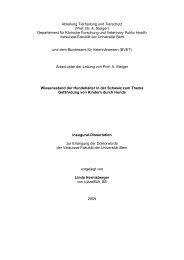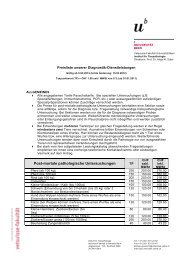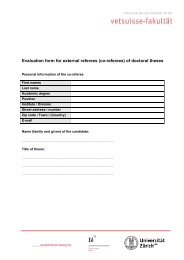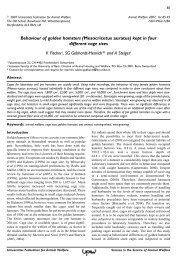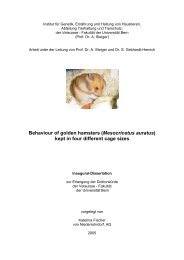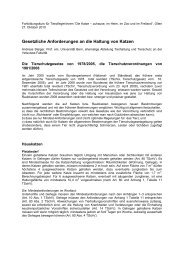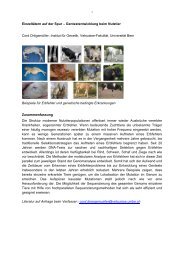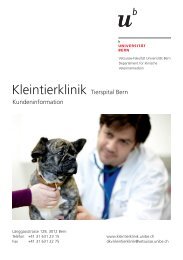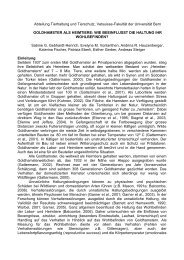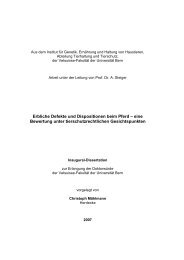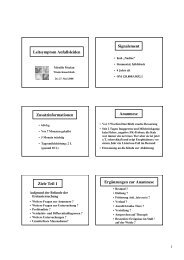:UR %XTREMZUCHTEN - Vetsuisse-Fakultät - Universität Bern
:UR %XTREMZUCHTEN - Vetsuisse-Fakultät - Universität Bern
:UR %XTREMZUCHTEN - Vetsuisse-Fakultät - Universität Bern
Erfolgreiche ePaper selbst erstellen
Machen Sie aus Ihren PDF Publikationen ein blätterbares Flipbook mit unserer einzigartigen Google optimierten e-Paper Software.
Resolution ist nachfolgend im englischen Originaltext<br />
leicht gekürzt aufgeführt, daneben gibt es gleichwertig<br />
den französischen Originaltext:<br />
Resolution on the Breeding of Pet Animals<br />
adopted on 10 March 1995 by the Multilateral Consultation of<br />
Parties to the European Convention for the Protection of Pet<br />
Animals (ETS 125)<br />
The Parties of the European Convention for the Protection of<br />
Pet Animals, by virtue of the terms of reference laid down in<br />
Article 15; [some introductory notes: deleted]<br />
Agreed:<br />
1. to encourage breeding associations, in particular cats and<br />
dogs breeding associations:<br />
– to reconsider breeding standards in order, if appropriate, to<br />
amend those which can cause potential welfare problems, in<br />
particular in the light of the recommendations presented in<br />
the Appendix;<br />
– to reconsider the standards and to select the animals taking<br />
into account not only aesthetic criteria but also behavioural<br />
characteristics (for instance with regard to problems of aggressiveness)<br />
and abilities;<br />
– to ensure, by good information and education of breeders and<br />
judges, that breeding standards are interpreted in such a way<br />
as to counteract the development of extreme characteristics<br />
(hypertype) which can cause welfare problems;<br />
– to raise public awareness to the problems related to some physical<br />
and behavioural characteristics of the animals;<br />
2. if these measures are not sufficient, to consider the possibility<br />
of prohibiting the breeding and for phasing out the exhibition<br />
and the selling of certain types or breeds when characteristics<br />
of these animals correspond to harmful defects such as those<br />
presented in the Appendix.<br />
Appendix<br />
The Parties are convinced that in the breeding of several breeds<br />
or types of pet animals, mammals and birds, insufficient account<br />
is taken of anatomical, physiological and behavioural<br />
characteristics which are likely to put at risk the animals› health<br />
and welfare. However, the Parties considered that problems connected<br />
with the breeding of cats and dogs should be addressed<br />
in priority. The Parties strongly encourage cat and dog breeding<br />
associations to revise their breeding policies in the light of<br />
Article 5 of the Convention taking account in particular of the<br />
following guidelines:<br />
Guidelines for the revision of breeding policies:<br />
– set maximum and minimum values for height or weight of<br />
very large or small dogs, respectively, to avoid skeleton and<br />
joint disorders (e.g. dysplasia of hip joints or elbows, fractures,<br />
luxation of elbow or patella, persistent fontanella) and<br />
collapse of trachea;<br />
– set maximum values for the proportion between length and<br />
height of short-legged dogs (e.g. Bassethound, Dachshund) 1<br />
to avoid disorders of the vertebral column;<br />
– set limits to the shortness of skull, respectively nose, so that<br />
breathing difficulties and blockage of lachrymal ducts are avoided,<br />
as well as disposition to birth difficulties (e.g. Persian<br />
cats, especially the «extreme type», Bulldogs, Japan Chin, King<br />
Charles Spaniel, Pug, Pekin Palacedog);*<br />
– prevent the occurrence of:<br />
– a persistent fontanella (e.g. Chihuahua) to avoid brain damages;<br />
– abnormal positions of legs (e.g. very steep line of hind legs<br />
in Chow Chow, Norwegian Buhund, Swedish Lapphund,<br />
Finnish Spitz; bowed legs in Bassethound, Pekin Palacedog,<br />
Shi Tzu) to avoid difficulties in movement and joint degeneration;<br />
– abnormal positions of teeth (e.g. brachygnathia in Boxers,<br />
Bulldogs, Persian Cats) to avoid difficulties in feeding and<br />
caring for the newborn;<br />
– abnormal size and form of eyes or eyelids (e.g. ectropium:<br />
Bassethound, Bloodhound, St. <strong>Bern</strong>ard; small deep lying eyes<br />
with disposition to entropium: Airedale Terrier, Australian<br />
Terrier, Bedlington Terrier, Bullterrier, Bloodhound, Chow<br />
Chow, English Toy Terrier, Jagdterrier, Newfoundland, Shar<br />
Pei; large, protruding eyes: Boston Terrier, Cavalier King<br />
Charles Spaniel, Dandie Dinmont Terrier, Brussels Griffon,<br />
Japan Chin, King Charles Spaniel, Pug, Pekin Palacedog, Shi<br />
Tzu, Tibet Terrier) to avoid irritation, inflammation and degeneration<br />
as well as prolapse of eyes;<br />
– very long ears (e.g. English Cocker Spaniel, Bassethound,<br />
Bloodhound) to avoid disposition to injuries;<br />
– markedly folded skin (e.g. Bassethound, Bulldog, Bloodhound,<br />
Pug, Pekin Palacedog, Shar Pei) to avoid eczemas<br />
and in the case of furrows around the eyes irritation and<br />
inflammation of eyes;**<br />
– avoid or, if it is not possible to eliminate severe defects, discontinued<br />
breeding of:<br />
– animals carrying semi-lethal factors (e.g. Entlebucher Cattledog);<br />
– animals carrying recessive defect-genes (e.g. homocygotic<br />
Scottish Fold Cat: short legs, vertebral column and tail defects)<br />
– hairless dogs and cats (lack of protection against sun and<br />
chill, disposition to significant reduction of number of<br />
teeth, semi-lethal factor)<br />
– Manx-cat (movement disorder, disposition to vertebral column<br />
defects, difficulties in elimination of urine and faeces,<br />
semi-lethal factor)<br />
– cats carrying «dominant white» (significant disposition to<br />
deafness);<br />
– dogs carrying «Merle factor» (significant disposition to deafness<br />
and eye disorders, e.g.: Blue merle Collie, Merle Sheltie,<br />
Merle Corgie, Merle Bobtail, Tigerdogge, Tigerteckel).<br />
1)<br />
The breeds mentioned in brackets are only examples in which the these<br />
problems may occur<br />
* vgl. Abb. 1 und Abb. 3, ** vgl. Abb. 2<br />
<br />
<br />
Aus der Erkenntnis, dass auch die Zuchtorganisationen,<br />
die Züchter und die Richter wesentliche Anstrengungen<br />
zur Zuchtverbesserung insbesondere in der Hunde- und<br />
Katzenzucht leisten müssen, haben 1995 im Europarat<br />
im Rahmen des obgenannten Europäischen Übereinkommens<br />
von 1987 zum Schutz von Heimtieren die<br />
Fédération Cynologique Internationale, die Fédération



